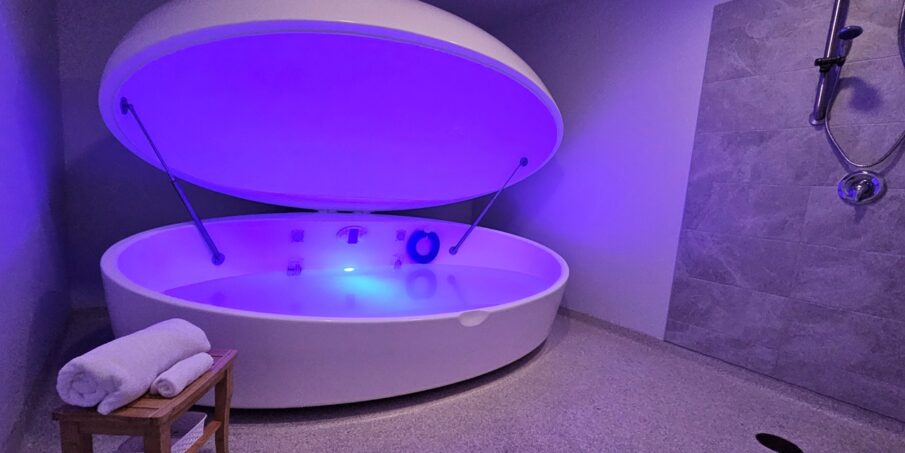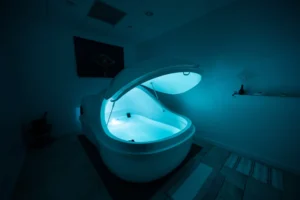In our fast-paced modern world, detoxifying the mind and body has become an essential practice for maintaining overall health and well-being. One powerful method gaining significant attention is Float Session Therapy. But what exactly is this therapy, and why is it considered ideal for detoxification? In this comprehensive guide, we’ll dive deep into the benefits of float therapy, the science behind float therapy, and how it can transform your mental and physical health.
Float Therapy: What Is It?
Float Therapy, also known as Sensory Deprivation Float Therapy or Isolation Tank Therapy, involves floating effortlessly in a specially designed tank filled with highly concentrated Epsom salt water. This environment is meticulously crafted to eliminate external stimuli, including light, sound, and touch, allowing your mind and body to enter a deep state of relaxation.
The purpose of sensory deprivation tank is to provide a space free from distractions, helping to reduce stress and promote healing. During a float therapy session, you experience weightlessness, which decreases pressure on your joints and muscles, enhancing relaxation and recovery.
The Science Behind Float Therapy
The science behind float therapy reveals fascinating insights into how this practice benefits the body and mind. Studies show that sensory deprivation can trigger significant physiological and psychological changes. When external stimuli are minimized, your brain reduces cortisol levels (the stress hormone) and increases endorphins, dopamine, and serotonin neurotransmitters associated with happiness and well-being.
The saltwater’s buoyancy also supports muscle relaxation and improves circulation, which contributes to detoxification. Additionally, the magnesium in Epsom salt is absorbed through the skin, aiding in muscle recovery and reducing inflammation.
Benefits of Float Therapy for Detoxification
1. Mental Detox: Reducing Stress and Anxiety
One of the most significant benefits of float therapy is its ability to cleanse the mind. The sensory deprivation environment allows your brain to slow down from its typical fast-paced processing, reducing anxiety and promoting mental clarity. This effect is especially valuable for those struggling with float tank anxiety or float therapy for depression.
2. Physical Detox: Muscle Recovery and Pain Relief
The magnesium-rich Epsom salt solution in the tank helps flush out toxins from your muscles, promoting healing and recovery. The benefits of float session therapy include pain reduction and relief from chronic conditions such as arthritis and fibromyalgia.
3. Enhanced Sleep Quality
A common effect experienced after a float therapy session is improved sleep. The deep relaxation and detoxification help regulate your body’s circadian rhythm, making it easier to fall asleep and stay asleep.
4. Boosted Immune Function
Regular float sessions have been shown to enhance immune system function by reducing inflammation and stress, two factors that weaken immunity.
5. Emotional Detox: Enhancing Mood and Creativity
The profound relaxation during sensory deprivation float therapy can clear emotional blockages and stimulate creativity. This is part of the float tank therapy benefits that many users report after consistent sessions.
What Are the Benefits of Sensory Deprivation Float Tanks?
Sensory deprivation float tanks offer a unique environment that supports both mind and body detoxification. The benefits of floatation tanks extend beyond relaxation to include:
- Lowered blood pressure
- Decreased muscle tension
- Enhanced focus and concentration
- Relief from headaches and migraines
- Support for meditation and mindfulness practices
Float Therapy Session: What to Expect
If you’re new to isolation tank therapy, you might wonder what happens during a float therapy session. Upon entering the float tank, you lie back and float effortlessly. The water is body temperature, and the high salt concentration keeps you buoyant. Most tanks are soundproof and lightproof, creating a tranquil environment. Sessions typically last 60-90 minutes.
After your session, many users report feeling refreshed, recharged, and mentally clear.
How Does Float Therapy Help With Depression and Anxiety?
Float therapy for depression and anxiety has gained popularity due to the therapy’s calming effects on the nervous system. The reduction in sensory input helps lower the brain’s overstimulation, which often exacerbates these conditions. The effects of float therapy include increased production of mood-enhancing chemicals and decreased stress hormones.
What Are the Health Benefits of Float Therapy?
- Pain relief and reduced muscle soreness
- Improved sleep and relaxation
- Enhanced mental clarity and mood stabilization
- Detoxification through magnesium absorption
- Reduced anxiety and depression symptoms
These health benefits of float therapy make it a holistic treatment option for mental and physical health.
Float Tank Therapy Benefits: More Than Just Relaxation
Many people initially try float tank therapy for relaxation but soon discover its broader benefits. Regular sessions can improve athletic performance, aid in injury recovery, and enhance mindfulness practices. The deep state of relaxation experienced during the session promotes healing on multiple levels.
Why Are Sensory Deprivation Tanks Used?
The purpose of sensory deprivation tanks is to create an environment free from sensory overload. In our everyday lives, constant noise, light, and movement bombard our senses, leading to stress and fatigue. These tanks provide a sanctuary where your mind and body can rest, repair, and detoxify naturally.
Effects of Float Therapy on the Body and Mind
The effects of float therapy include decreased cortisol levels, reduced inflammation, and increased production of natural painkillers. Mentally, the therapy promotes emotional stability and helps manage symptoms of PTSD and anxiety.
How Float Therapy for Relaxation Supports Wellbeing
By promoting deep relaxation, float therapy for relaxation helps reset your nervous system. This reset can improve mood, decrease anxiety, and promote a healthier lifestyle.
Frequently Asked Questions (FAQ)
Q1: How often should I do Float Session Therapy to see detoxification benefits?
A1: For best results, many recommend at least one session per week, but even monthly sessions can promote noticeable benefits of float therapy.
Q2: Is Float Therapy safe for people with anxiety or claustrophobia?
A2: Yes! Many people with float tank anxiety find that gradual exposure helps them relax. Communicating with your therapist before your float therapy session can ensure a comfortable experience.
Q3: Can Float Session Therapy help with chronic pain?
A3: Absolutely. The float tank therapy benefits include pain relief and muscle recovery, making it useful for chronic pain sufferers.
Q4: What should I bring to my Float Therapy Session?
A4: Usually, nothing special is needed. Most centers provide towels and toiletries. Avoid caffeine beforehand for optimal relaxation.
Q5: How long is a typical Float Therapy session?
A5: Sessions typically last 60 to 90 minutes, enough time for full relaxation and detoxification.
Q6: Can Float Therapy replace traditional medical treatments?
A6: Float Therapy is complementary. It can enhance traditional treatments but should not replace medical advice or prescribed treatments.
Conclusion
Float Session Therapy offers a unique and powerful way to detoxify both your mind and body. The combination of sensory deprivation, magnesium-rich water, and weightlessness produces profound health benefits of float therapy. From reducing stress and anxiety to easing muscle pain and enhancing sleep, the benefits of float therapy are well-supported by science and experience. Whether you are seeking relief from depression, anxiety, or just want to experience deep relaxation, float therapy for relaxation is an ideal, natural approach to healing and wellness.
Ready to experience the float therapy session for yourself? Embrace the journey toward a detoxified mind and body today!





